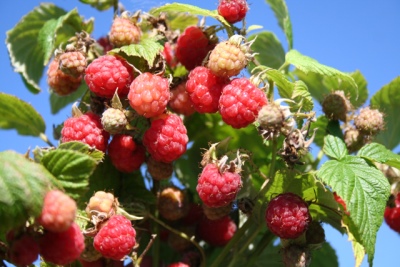
- Authors: Finland
- Taste: sweet, honey
- Ripening period: average
- Frost resistance: frost resistance up to -40 ° С
- Appointment: for fresh consumption, for juicing and freezing
- Fruiting period: at the end of July
- Pruning: spring tenderloin of dry shoots
- Yield rate: high
- Appeared when crossing: princess x raspberry
- Synonyms (or Latin name): Heisa
The Hayes raspberry variety belongs to a new species. In Russia it is very popular among summer residents and gardeners. The variety fell in love with its simplicity in care, high resistance to pests and for its taste.
Breeding history of the variety
The authors of the Hayes raspberries are breeders from Finland. The variety appeared when crossing the prince plant and the usual raspberry. The Latin name is Heisa.
Description of the variety
The shoots of the bushes are erect, very tough and thorny. Triangular spines are located throughout the shoot. The height of the bush reaches 150–180 cm. The variety is characterized by low formation of new branches.
Ripening terms
Hayes has an average ripening period. Fruiting begins at the end of July and lasts 2 weeks.
Growing regions
Raspberry Hayes is grown in almost all regions of Russia. Due to its winter hardiness, it is very common in the northern regions.
Yield
The variety is high-yielding.
Berries and their taste
The berries are round-conical in shape, bright red in color. The weight of one berry is 4–5 g. The taste is sweet, honey, there is a slight sourness, the aroma is pronounced, berry. The fruits have a universal purpose. They are consumed fresh, as well as juices are harvested and frozen.

Growing features
Raspberries are planted in early spring or autumn, after fruiting. For spring planting, the soil begins to be prepared in the fall, for autumn planting - at least 3 weeks before planting. Large seedlings take root very poorly, so a plant with a height of about 0.7 m is chosen. The seedling should have 2 stems with a good root system.
Raspberries are planted in 2 ways: dimple and trench. With the pit method, the distance between the bushes should be 1 m, and between the rows - at least 2 m. Before planting, the root system of the seedlings is placed in a mullein solution mixed with the ground. This exercise improves root engraftment.
When planting in a trench, the distance between the rows should be 1 m. The seedlings in the trench are planted at a distance of 40 cm from each other. Before placing the plants in the ground, organic and mineral fertilizers are poured into the trench.
After planting, the plants are watered abundantly and mulched for better moisture retention. In order for the seedlings to take root well, they are pruned. The height of the seedling after pruning should be 30 cm.
In one place, raspberry bushes can grow for no more than 10 years, after which the soil becomes poor in vitamins. The bushes begin to grow poorly, and the yield is significantly reduced.
Site selection and soil preparation
For raspberries, choose a well-lit area with a slight slope. If there is not enough sunlight for the bushes, young shoots begin to stretch out and shade other stems. The soil at the planting site should be loose, light, with neutral acidity.


Pruning
Prune raspberry bushes in the spring. Remove dry and frozen shoots. They also carry out sanitary pruning as needed during the season.

Watering and feeding
The crop belongs to a drought-resistant variety. Watering is carried out rarely, but abundantly. According to the standard scheme, the bushes are watered 3 times per season: in the spring - during the formation of ovaries, in the summer - at least 4 times in 3 months, in October - before preparing for winter.
Raspberries are fed 3 times per season. In the spring, nitrogen fertilizers, wood ash and superphosphate are mixed with water. The solution is poured onto the root system. During flowering, fertilizers are applied based on potassium and superphosphate, as well as wood ash and urea. In the autumn, the bushes are fed with organic fertilizers, thereby replenishing the lost nutrients.
If the bushes grow weak, then additional feeding is made in the form of manure diluted with water. At least 3 liters of solution are poured under each bush.


Frost resistance and preparation for winter
Raspberries of this variety are very winter hardy. It can hibernate at temperatures down to -40 °. If the region is winter with low snow cover, the bushes are covered with a special canvas. Shelter is not required if the snow cover is large enough.

Diseases and pests
The variety is very well adapted to infections and pests, therefore, only preventive measures are taken against pests and diseases. Insects that can harm the culture: raspberry beetle or fly, strawberry-raspberry weevil. Rarely, bushes can get sick with powdery mildew, anthracnose, didimella.

Unfortunately, raspberries, like other plants, do not bypass various diseases and pests.Only armed with the knowledge and the necessary means for this, you can cope with such troubles. To help the plant, it is very important to be able to recognize the disease in time and begin timely treatment.
Reproduction
The variety does not form new shoots well, therefore, the method of dividing the bush is suitable for reproduction. Reproduction occurs as in all remontant varieties.

Review overview
Amateur gardeners and summer residents speak only positively about Hayes raspberries. This variety is very easy to care for. Even small berries do not bother summer residents, since they just taste great.







































































